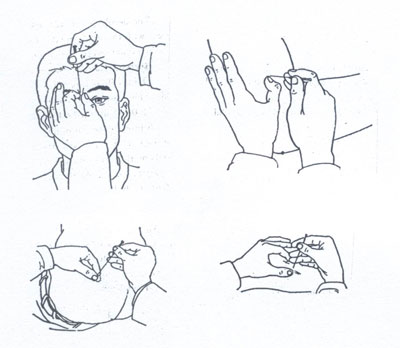Basic Insertion Techniques
Due to the anatomical features of the acupoints and personal experiences, needle insertions vary among acupuncturists. Generally, the needle is inserted using both hands. In one hand, acupuncturists hold the needle between 15 degrees to 90 degrees to the skin surface, they will use another hand to press, hold-up, or stretch the local skin surface and then guide the needle to be inserted in appropriate speed, force, depth and direction. Alternatively, a needling guide tube can be used. The needle is inserted into the tube and placed firmly on the point; acupuncturists then tap firmly on the handle of needle so that it penetrates the skin. The guide is then removed and the needle is further adjusted as required.
Traditionally, acupuncture involves several needle insertion techniques, each tailored to specific therapeutic goals, patient conditions, and acupuncturist styles. Here are the basic needle insertion techniques commonly used:
1. Perpendicular Insertion
The needle is inserted at a 90-degree angle to the skin surface, which is suitable for regions with thick muscle layers, such as buttocks or thighs.
2. Oblique Insertion
The needle is inserted at a 45-degree angle on the skin surface, which is ideal for areas with thin muscle layers or where the underneath structures (e.g., bones or organs) need to be avoided, such as the chest or back regions.
3. Transverse Insertion (Subcutaneous)
The needle is inserted at a 15- to 30-degree angle, almost parallel to the skin surface. This is used for shallow insertions, such as on the scalp or over bony prominences.
4. Directional Insertion
The needle is inserted in a specific direction in considering the qi flowing or the meridian pathway. This is used for enhancing or reducing the flow of qi in a particular meridian.
5. Fast Insertion
The needle is inserted quickly to minimize discomfort. Indication: Often used for patients who are sensitive to pain or anxious about the procedure.
6. Slow Insertion
The needle is inserted gradually, allowing the acupuncturist to feel tissue resistance and adjust accordingly. This is useful for deeper insertions or when precise placement is required.
7. Multiple Insertions
Several needles are inserted in a specific pattern or sequence. This is used for complex conditions or to stimulate multiple points simultaneously.
After the needle is inserted, physicians will look for the occurring of needling sensation. TCM calls this de qi literally, the "arrival of qi". The patient may feel a dull ache, heaviness, distention, tingling, or electrical sensation either around the needle or traveling up or down the affected meridian. Meanwhile, the acupuncturist may experience tightness and dragging around the needle like a fish taking the bait. This needling sensation varies greatly from person to person. Pain is not an expected response to most acupuncture stimulation, though certain acupoints may have some occasional pain.
TCM focuses on this needling sensation, which can be influenced by many factors, such as the body constitution of patients, severity of the illness, location of the acupoints and the needling techniques. In general, if the needling sensation occurs easily and it can travel to stimulate the lesion, the therapeutic effect will be better; if it is difficult to achieve, then the effect is not so good. For individuals who get this sensation slowly or lightly, the acupuncturist will further manipulate to adjust the position, direction and depth of the needle. It may include techniques like lifting and thrusting the needle into place, twirling the needle in a specific manner, plucking or scraping the handle of the needle, and also pressing the skin up and down along the course of the meridian with the fingers.

Once again, techniques are carefully chosen based on the condition of the patient and the location of the acupoints. Common factors to determine the needling techniques include those with strong bodies or the more muscular regions may be inserted deeper and can accept more vigorous techniques; while the elderly, small children and those with a weak body, and for those regions with a thin skin layer should have shallower needle insertions and be stimulated more gently.


